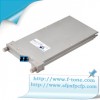标准光模块

CFP4 Optical Transceiver
Specifications
- 产品型号: CFP4-100G-X
- 兼容品牌: 全系列
- 封装类型: CFP4
- 传输速率: 100G
- 传输距离: Up to 40KM transmission
- 发射波长: 850nm/1310nm/1550nm/BIDI/CWDM/DWDM 可选
- 接收波长: 850nm/1310nm/1550nm/BIDI/CWDM/DWDM 可选
- 工作温度: 商业级0℃~+70℃/工业级-40℃~+85℃ 可选
- 数字诊断: 带DDM
- 接收灵敏度: Up to 40KM transmission
- 接收灵敏度: Up to 40KM transmission
Description
This CFP Multi-Source Agreement (MSA) defines the CFP4 form factor of an optical transceiver which can
support 40Gbit/s and 100Gbit/s interfaces for Ethernet, ITU-T OTN and other applications. Specifications
provided in this document are given as a “delta” to the CFP MSA Hardware Specification Rev.1.4 or the
CFP2 Hardware Specification Rev. 1.0.
The CFP4 electrical interface will vary by application, but the nominal signaling lane rate is 25Gbit/s per lane
and documentation is provided in OIF CEI-28G-VSR, CAUI-4, and OTL4.4 electrical interface specifications.
The CFP4 electrical interface can also optionally support a nominal signaling lane rate of 10Gbit/s and
documentation is provided in XLAUI, XLPPI, OTL3.4 and STL256.4. The CFP4 module may be used to
support single mode and multimode fiber optics.
The CFP4 modules and the host system are hot-pluggable. The module or the host system shall not be
damaged by insertion or removal of the module.
CFP MSA is an acronym for 100G
1.3 FUNCTIONAL DESCRIPTION
The CFP4 module is a hot pluggable form factor designed for optical networking applications. The module
size has been chosen to accommodate a wide range of power dissipations and applications. The module
electrical interface has been generically specified to allow for supplier-specific customization around various
“4 x 25Gbit/s” and 4 x 10Gbit/s interfaces.
1.3.1 Hot Pluggable
A CFP4 module is defined to be hot pluggable. Hot Pluggable is defined as permitting module plugging and
unplugging with Vcc applied, with no module damage and predictable module behavior as per the State
Transition Diagram. As shown in Figure 5-6: Pin Map Connector Engagement, the Module Absent
(MOD_ABS) pin and Module Low Power (MOD_LOPWR) pin are physically guaranteed to be one of the last
pins to mate.
2 CFP4 HARDWARE SIGNALING PINS
The control and status reporting functions between a host and a CFP4 module use non-data control and
status reporting pins on the 56-pin connector. The control and status reporting pins work together with the
MDIO interface to form a complete HOST-CFP4 management interface. The status reporting pins provide
status reporting. There are three (3) Hardware Control pins, two (2) Hardware Alarm pins, and six (6) pins
dedicated to the MDIO interface. Specification of the CFP4 hardware signaling pins are given in Ref.[1] with
the following changes listed in this document.
2.1 Hardware Control Pins
The CFP4 Module supports real-time control functions via hardware pins, listed in
Table 1-1. Specifications of the CFP4 hardware control pins are given in Ref.[1], with the following changes
listed below.





